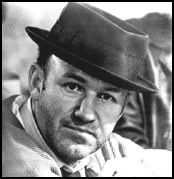It’s hat season. So I wandered over to Byrnie Utz Hats, looking to keep the sun out of my eyes and the carcinomas off my face, but mostly looking for an excuse to enter this crazy closet of anachronism and find out: Can I pull off a hat?
I’m definitely torn about hats. I don’t want to be some kind of retro speakeasy fop, like the guy I often see stationed in the cigarette klatch outside the Lusty Lady; and I don’t want to be one of these bowler-headed, double-breasted types, like the London banker in a Monty Python skit. I’m not ripped enough, gay enough, or country enough to wear a Western hat. I don’t like crazy hats that are just an easy ticket to “personality,” and I hate above all the witless tedium of the baseball cap. But I have just enough nostalgia for old-fashioned manhood—and just enough naked skull—to long for a real man’s hat. I took my ambivalence to Byrnie Utz Hats.
Byrnie Utz (pronounced Ootz) is one of the oldest shops in downtown Seattle. It’s been on Union Street near Third for almost seventy years. Back when everyone wore a hat—straw in the summer, felt in the winter—downtown supported eight such emporiums. Hats (their sales, cleaning, and repair) took up an entire floor at the Bon March鮠Now Utz is one of just 18 specialty stores left in the country—or so say the hat distributors who come calling.
How can this place possibly survive, when even the bald guys are trying to get over as young and sporty, when even Stetson, for chrissakes, has put its storied name on a friggin’ baseball cap? “People always ask me that,” says Paul Ferry, who runs the shop with his wife, Bev. His answer: “The door’s still open, isn’t it?”
Ferry took over the shop from the Utz’s in-laws back in 1990, after apprenticing for 15 years—and the evidence suggests he’s losing neither his shirt nor his lease. He concedes business used to fall off a cliff in the spring and summer, but “that was before the skin cancers. That’s helped bring back the summer hats.”
The sales floor is staffed with three friendly club kids in Kangols, the tables meticulously stacked with all manner of headwear (countless cowboys, dozens of Derbys, Panamas, fisherman hats, Rasta knits, some floppy women’s straws), and the narrow aisles threaded by a surprising number of customers (dapper Caribbean gentleman, bike messenger, odd fellow picking up his French Foreign Legion style chapeau). Of course, Utz caters to aficionados and the Orville Redenbacher set: Members of the “bow-tie club” come in for the boater—a flat-top straw number like you’d see on FDR—as do barbershop quartets. But he sells plenty of furry Kangols to the playaz too, even in summer.
The floor-to-ceiling glass-doored cabinets are original 1930s fixtures, as are the neat hinged, paneled mirrors that extend from them. A few select movie posters—Bogart and Cagney, Steve McQueen, Jimmy Stewart, all in Stetsons—predictably enhance the vintage flavor. Hollywood hasn’t done much to boost sales since the Indiana Jones series, Ferry says, although Samuel L. Jackson’s fondness for Kangol—on display in Jackie Brown—has been a boon.
It seems odd that in a culture of obsessive recycling, classy men’s hats have yet to get a serious GQ revival. What better to wear in your PT Cruiser or Thunderbird ragtop as you drive to the old-timey baseball field? Ferry says the cigar craze provided a bit of a lift; yet he’s content to see hats remain out of the retailing spotlight. “Nordstrom will send us two to three customers a day,” he says.
So what’s the priciest Utz item that I could place on my unworthy head? Ferry pulls down a $600 Panama by Borsalino, which he hazards took six weeks of work from a master craftsman in Ecuador. A nice weave, but not my style. I gravitate to a more cut-rate item, a crushable fedora, not unlike what I’ve seen the Edge wear.
I look in the mirror. McQueen gazes down approvingly. Damn, I look good. Ferry punctures the glamour a little by advising me not to pick up the hat Hollywood-style, by the crown, but rather by the brim—which somehow makes me feel more like Willy Loman than Philip Marlowe. I pack my new purchase up and carry it to the office, not quite ready to face the world from beneath a brim. Back at my desk, I slip a “Press” card in the hatband, put it on, and begin to write.
mfefer@seattleweekly.com 








